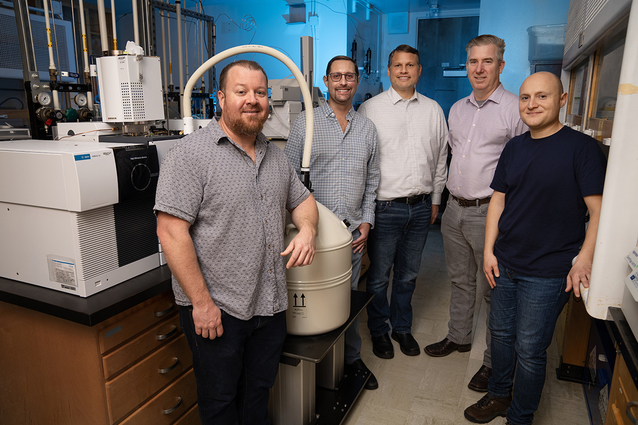Hot stuff: A new thermal pathway for a high explosive
 (Download Image)
(Download Image)
Left to right: Keith Morrison, Jason Moore, Keo Springer, Keith Coffee and Batikan Koroglu stand in front of the cryo-focused pyrolysis GC-MS (gas chromatography mass spectrometer). The team used this instrument to capture and cryo (liquid nitrogen) trap the gases that evolve from high explosives as they thermally decompose. Photo by Blaise Douros/LLNL.
TATB (1,3,5-triamino-2,4,6-trinitrobenzene) is an important explosive compound because of its extensive use in munitions and world-wide weapons systems. Despite its importance, researchers have been trying to understand its response to temperature extremes for the past 50 years.
A Lawrence Livermore National Laboratory (LLNL) team has uncovered a new thermal decomposition pathway for TATB that has a significant bearing on computational models that predict the energy release and thermal behavior of TATB and possibly other insensitive high explosives (IHEs). The research appears in Scientific Reports and a just-published special issue of the journal Propellants, Explosives, Pyrotechnics, with a series of papers on TATB thermal decomposition.
TATB is widely viewed as the most stable IHE, as it is not easily detonated by external stimuli. It does not undergo the thermal sequence of deflagration-to-detonation (DDT), unique among explosives. It requires a proper detonation chain to initiate, so handling the material is relatively free from accidental initiation if proper safety methods are followed.
One aspect of this safety envelope is how the material responds to temperature extremes; whether this material becomes more sensitive and is no longer safe to handle when subjected to abnormal thermal environments.
“Our goal with this project was to understand the behavior experimentally to construct computational models predicting behavior for any thermal exposure conditions,” said LLNL scientist Keith Morrison, a co-author of the work.
The study has established a new understanding of IHE decomposition and lays the foundations for linking complex molecular processes to kinetic and thermodynamic measurements of IHE.
“This new decomposition reaction of TATB has traditionally been overlooked in the literature, and our study highlights novel molecular pathways occurring as IHE is heated above its stability limit,” said LLNL scientist John Reynolds, also a co-author. “These pathways can help constrain the physiochemical properties of current and future IHE compounds, allowing for predicting behavior and safe handling of energetic materials.”
This project was originally started by Evan Kahl (currently working at Chemring Energetic Devices in Illinois), who helped build many of the core concepts that the LLNL team went on to prove. Other LLNL researchers associated with this work include Ana Racoveanu, Jason Moore, Batikan Koroglu, Keith Coffee, Adele Panasci-Nott, Gregory Klunder, Bradley Steele, Matt McClelland, Alan Burnham (from Sratify/MH Chew Associates), Art Nelson, Harris Mason (now at LANL), Chris Colla, Nick Muetterties, John Densmore, Jonathan Crowhurst, Jason Olivas, John Selinsky, Peter Hsu, Ben Yancey (now at Gallo), Taylor Miller and Joe Van Horn.
Contact
 Anne M. Stark
Anne M. Stark
[email protected]
(925) 422-9799
Related Links
Scientific ReportsPropellants, Explosives, Pyrotechnics
Tags
Nuclear, Chem, and Isotopic S&TDefense
Energy
Physical and Life Sciences
Strategic Deterrence
Materials Science
Nuclear and Chemical Sciences
Featured Articles








